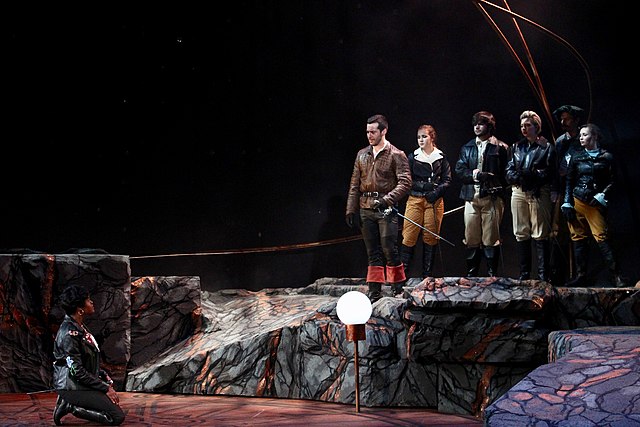‘Life is a Dream’ questions being born into honor
The cast of “Life is a Dream” during the University of Arkansas performance of the play on stage.
February 13, 2023
Pockets of chatter filled the Sally Stevens Players Theater. Director Stanton Davis’ voice could be heard just above the crowd, telling a performer’s partner that “she’s a little badass.”
With the lights dimming, a figure in a red robe stepped out from behind the black curtain in the theater. A beard of silver lined the man’s face. Each step he took was purposeful and contained a heft that can only be understood as power. His shoes, all black with rubber soles, boomed through the silent stage. A crown on his head could only mean one thing.
“Are you not going to clap for your king?” he bellowed to the crowd.
Every person in the theater, some out of shame, clapped as violently as seemed possible.
“Life is a Dream” is a play by 17th century Spanish playwright Pedro Calderón de la Barca. The version on stage at NIU is translated by Harley Erdman and Lauryn E. Sasso.
Before the play even started, Jack Gordon, a junior acting major, who was playing King Basilio was commanding the audience’s pure attention.
“It’s all about the why,” said Gordon. “You have to be stern because you’re the king. You don’t have a choice.”
Gordon had a varied performance of Basilio. At moments he was comical and over-the-top, the epitome of physical humor, at others, he was on his knees begging for his life in a way that felt just as true as the humor.
In this way, Gordon is certainly not alone. Kristen Serbia, a junior acting major, Kayla Crispino, a sophomore acting major, Emma Mansfield, a junior acting major, and Emma Vaughn, a junior acting major all stand out in their roles for their well-rounded and nuanced performances of their characters. Even members of the chorus were able to make their characters feel real and added depth to the production.
Centering in on the main conflict, Mansfield’s Segismundo was absolutely stunning. They took over this character that is full of ambiguity and anguish and found the human qualities in him.
On a stage full of actors who embodied and emboldened their characters, Mansfield stood out.
“The famous speech in the second act, usually it’s a cry of anguish,” said Bruce Burningham, a professor at Illinois State University and the President of the Association for Hispanic Classical Theater. “One of the things I thought was really innovative about this production was the way in which the actor who plays Segismundo put nuance into it.”
Similarly, Vaughn’s Rosaura held an emotional and intellectual strength that mirrored Mansfield’s Segismundo. Vaughn was able to portray Rosaura as a mix of the standard depiction of women of the time of the play’s writing, emotional and romantic, and the more masculine aggressive sides of her character. Vaughn held her own in her sword fights and looked comfortable wielding and carrying weapons.
In a conversation after the show with Mansfield and Vaughn, they talked about how the show led to personal growth.
It wasn’t all serious though. By the end of the conversation, Vaughn wanted to show off her version of “Despacito,” “Sexy-mundo.”
To see the show, unfortunately lacking a performance of “Sexy-mundo,” there are performances at 7:30 p.m. on Feb. 16 and Feb. 17 and 2 p.m. on Feb. 18. Tickets, which are free for students, are available to purchase at the university tickets website.



